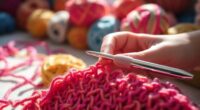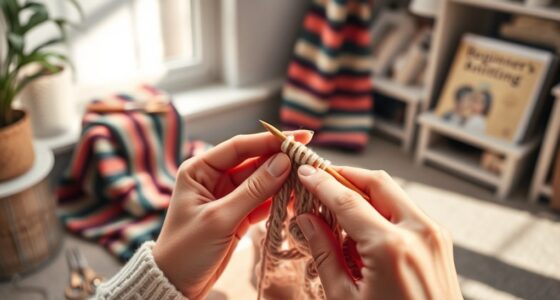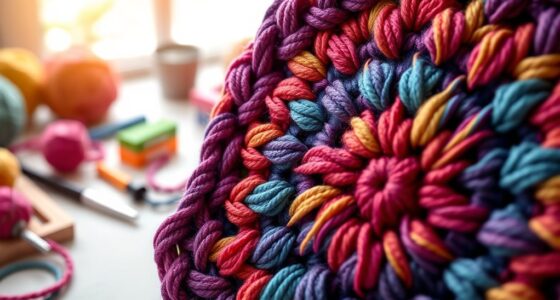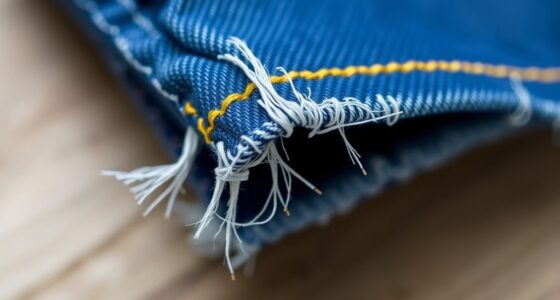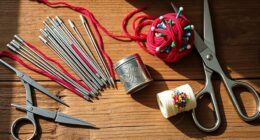Crochet's intricate loop-by-loop process makes it tough for machines to replicate authentically. Although some machines can mimic basic crochet patterns, they lack the finesse of human touch and creativity. Handcrafted items exhibit unique designs and superior craftsmanship that machines can't achieve. The artistic essence of crochet relies heavily on skilled artisans, ensuring each piece is a personal expression. If you're curious about the nuances of this craft and its future, there's more to uncover.
Key Takeaways
- Crochet requires a unique loop-by-loop technique that machines struggle to replicate accurately.
- Machines can mimic basic crochet patterns but fail to achieve the complexity of authentic designs.
- Precise yarn tension and intricate stitch control are essential, which machines cannot consistently manage.
- Handcrafted crochet reflects individual artistry and personal touch, elements that machines cannot provide.
- Current technology lacks the capability to fully replicate the unique textures and creativity found in handmade crochet items.
What Is Crochet?
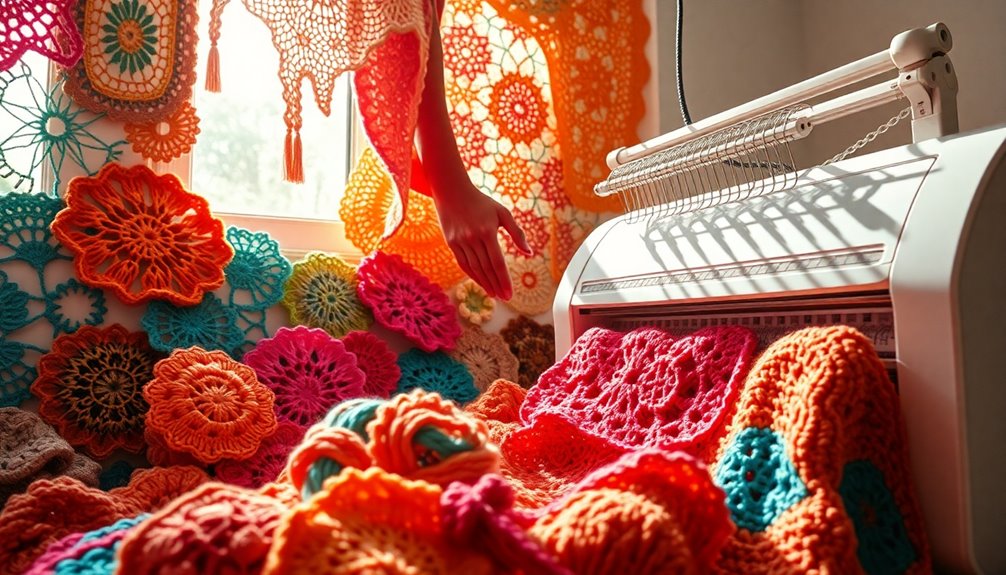
Crochet is an enchanting craft that transforms yarn into beautiful textiles using just a single hook. By manipulating loops through various stitches, you can create intricate designs and unique patterns that stand out.
Unlike knitting, which requires two needles, crochet's single-hook technique allows for a distinct approach to crafting. You start with a slip knot and pull up loops through stitches, customizing your project as you go.
The versatility of crochet means you can experiment with different stitches, leading to endless possibilities in texture and design. Each piece you create is a reflection of your creativity, making every crochet project truly one-of-a-kind. Additionally, like many crafts, engaging in crochet can serve as a form of stress relief and contribute to overall well-being.
Immerse yourself in this enthralling world and release your imagination with every loop and stitch.
The History Of Crochet

While many people enjoy the art of crochet today, its history reveals a rich tapestry of cultural influences and evolving techniques.
Crochet's origins trace back to the 15th and 17th centuries, with hints of Arabian and South American traditions. The term "crochet," derived from the French word for "hook," highlights the essential tool for this craft.
In the early 19th century, crochet gained traction, particularly after the first crochet pattern was published in 1824. The 1800s showcased intricate lace works, emphasizing the craftsmanship and artistry of crocheters.
Can We Crochet With A Machine?
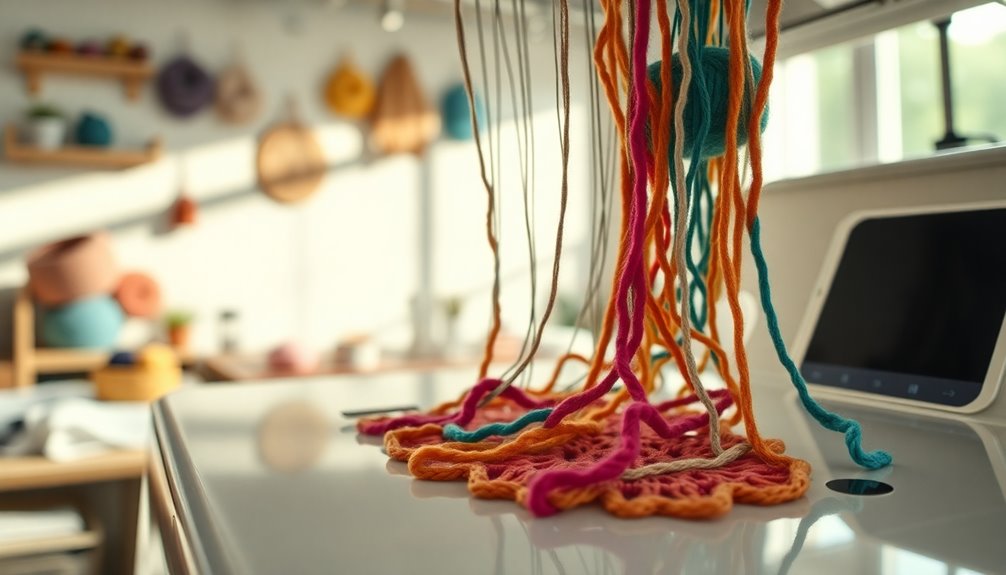
The intricate art of crochet, with its rich history and cultural significance, raises an interesting question: can this craft be performed using machines?
While knitting can be automated, crochet's complex loop-by-loop process makes it challenging for machines to replicate. The dexterity needed for hand crochet is vital, as each stitch relies on human finesse and tension control that machines struggle to achieve.
Although some crochet machines, like COMEZ, are advanced knitting machines using multiple yarns and needles, they can't produce authentic crochet designs. They may approximate crochet-like patterns, but they lack the intricate nature of true hand-crocheted items.
Ultimately, the unique loops and stitches of crochet require significant human involvement that machines simply can't match.
Why There Are No Crochet Machines?
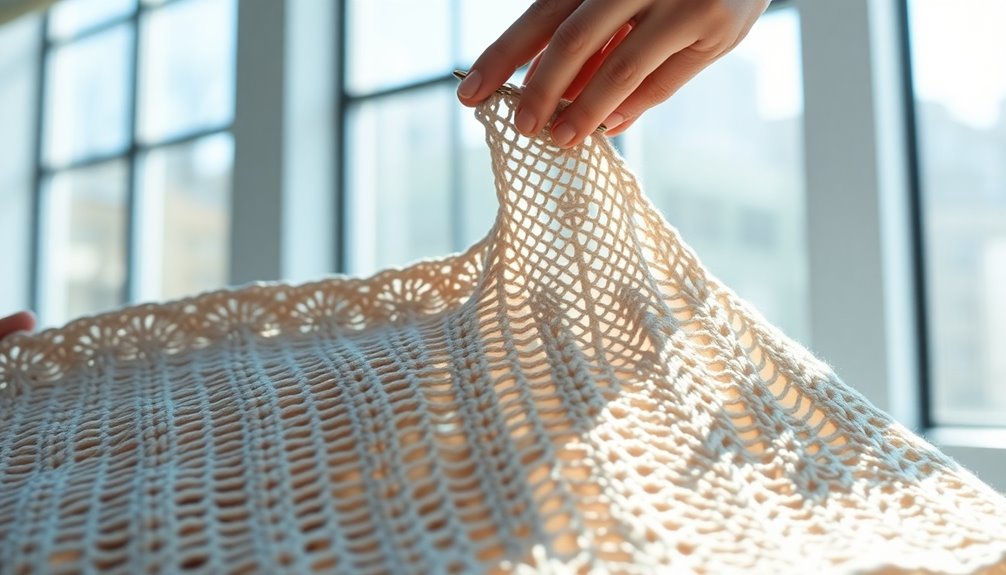
Although many might wonder why machines haven’t successfully embraced crochet, the answer lies in the craft’s inherent complexity. The intricate patterns and delicate stitches require a level of dexterity and intuition that machines struggle to replicate. Additionally, each project can vary significantly based on yarn type, tension, and even the crocheter’s personal style, presenting unique crochet challenges and difficulties. As a result, while technology has advanced in many areas, the nuanced art of crochet remains firmly rooted in human hands.
Unlike knitting, crochet requires a lot of simultaneous loop manipulation, making it challenging for machines to replicate. The intricate patterns and free-flowing nature of crochet stitches demand precise yarn tension, which machines can’t achieve. This unique aspect of crochet not only contributes to its artistic charm but also explains why crochet projects twist and shift unpredictably during the creation process. The flexibility in stitch formation allows creators to express their individuality, yet it also means that each piece can behave differently under varying tension. As a result, achieving uniformity in crochet can be quite a task, enhancing the artistry behind handmade creations.
In addition, the skill required for handcrafted crochet is a blend of artistic expression, skill, and creativity that current technology can't fully replicate.
While some machines can mimic crochet-like designs, they fall short of capturing the true textures and uniqueness of genuine crochet pieces.
Until technology advances further, the artistry of crochet remains a beautifully human endeavor that machines can't replace.
Can We Use Warp Knitting Machines For Crochet?
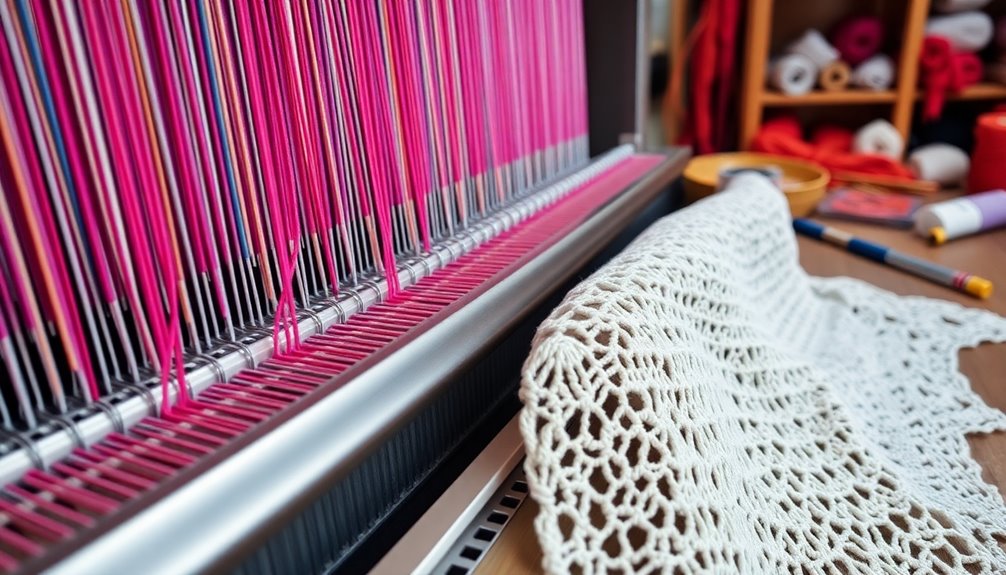
Given the challenges of creating true crochet machines, some might wonder if warp knitting machines can serve as a viable alternative.
While these machines can produce fabric with a crochet-like appearance, they fundamentally lack the ability to replicate the artistry of handmade crochet.
Here's what you should know:
- Warp knitting machines use multiple yarns and needles.
- They can't create intricate patterns with closed stitches.
- All loops remain open, altering texture and structure.
- Transverse chains, essential to crochet, can't be reproduced.
- Efficiency in production doesn't match the uniqueness of handmade crochet.
In essence, while warp knitting machines can mimic certain aspects of crochet, they fall short in delivering the true essence of this beloved textile art.
The Distinction Between Handmade and Machine-Made Crochet Items
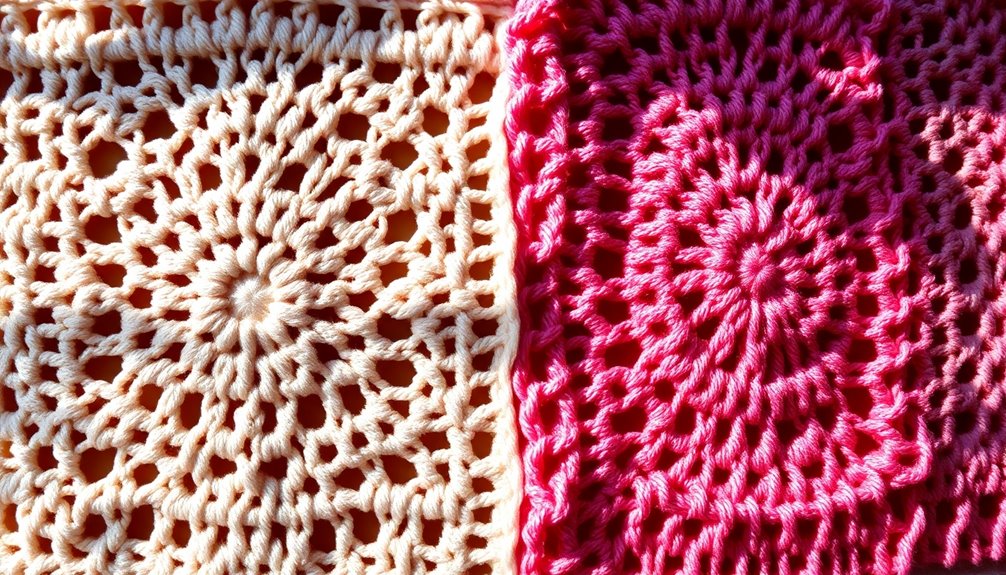
When you compare handmade and machine-made crochet items, you'll notice significant differences in craftsmanship and quality.
Handmade pieces showcase unique designs and superior materials, reflecting the artist's creativity and skill.
In contrast, machine-made items often lack the intricate details and personal touches that make crochet special.
Unique Craftsmanship Differences
While machine-made crochet items can mimic basic patterns, they lack the unique craftsmanship that defines handmade pieces. The intricate designs of handmade crochet items showcase the artisan skill and creativity, resulting in authenticity of hand that machines simply can't replicate.
Here's what sets them apart:
- Unique designs reflecting personal style
- Individual tension and stitch placement
- Emotional value linked to time and effort
- Mastery of crochet techniques passed down through generations
- A personal touch that machine-made crochet lacks
In essence, the craftsmanship differences lie in the attention to detail and the heart infused in every loop of handmade creations.
Each piece becomes not just an item, but a true work of art that resonates with its creator's spirit.
Quality of Materials
The quality of materials plays a significant role in distinguishing handmade crochet items from their machine-made counterparts.
Handmade pieces often use high-quality yarns, ensuring durability and a unique texture that machine-made items typically lack. In contrast, mass-produced crochet often relies on lower-quality yarns to cut costs, compromising the feel and longevity of the product.
Artisans choose yarns based on properties such as softness and colorfastness, adding character that machines can't replicate. The intricate details and personal touches in handmade crochet showcase the skill and creativity of the artisan, enhancing their perceived value.
Consumers who prioritize ethical sourcing and craftsmanship are more likely to invest in handmade crochet items, reflecting the care put into selecting quality materials.
Design and Creativity
Although machine-made crochet items can mimic certain designs, they often lack the unique flair that handmade pieces possess.
Handmade crochet items showcase intricate patterns and unique loops, reflecting the artisan's individual skill and creativity. The emotional value tied to these pieces comes from the time and effort invested by human crafters.
In contrast, machine-made crochet often results in:
- Uniformity and lack of individuality
- Limited craftsmanship and detail
- Absence of personal touch
- Lower emotional and cultural value
- Mass production over artistry
While machines can create crochet-like designs, they can't replicate the nuanced techniques that make handmade items truly special.
That's why consumers often pay a premium for these authentic treasures.
The Future of Crochet and Production Techniques
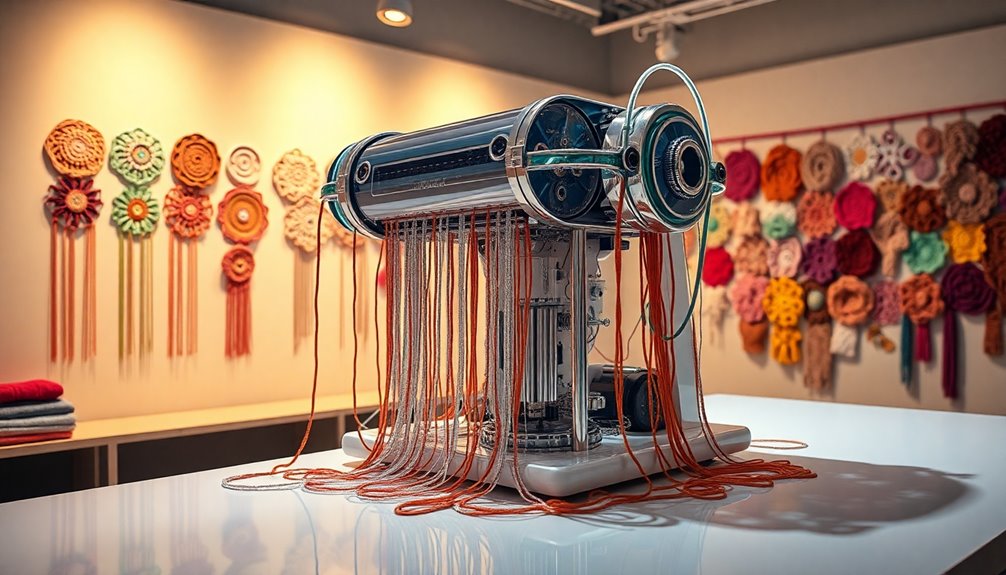
As technology advances, the future of crochet and production techniques is evolving, sparking interest in how automation might reshape this beloved craft.
While machines can create items that mimic crochet, they struggle to replicate the complex nature of crochet's intricate stitches and the uniquely human touch of hand-crocheted items.
Technological advancements, like robotic arms and digital fabrication, aim to automate the crochet process, focusing on patterns and designs that capture human artistry.
However, achieving the same authenticity and uniqueness remains a significant challenge.
As you explore this future, remember that the appeal of crochet lies in its handcrafted essence, which could be diluted if production shifts entirely to mechanization, losing the charm of creativity and individual expression. Additionally, understanding the importance of handcrafted essence can help appreciate the value of traditional crochet techniques amidst the rise of machine production.
The Impact of Mass Production on Crochet
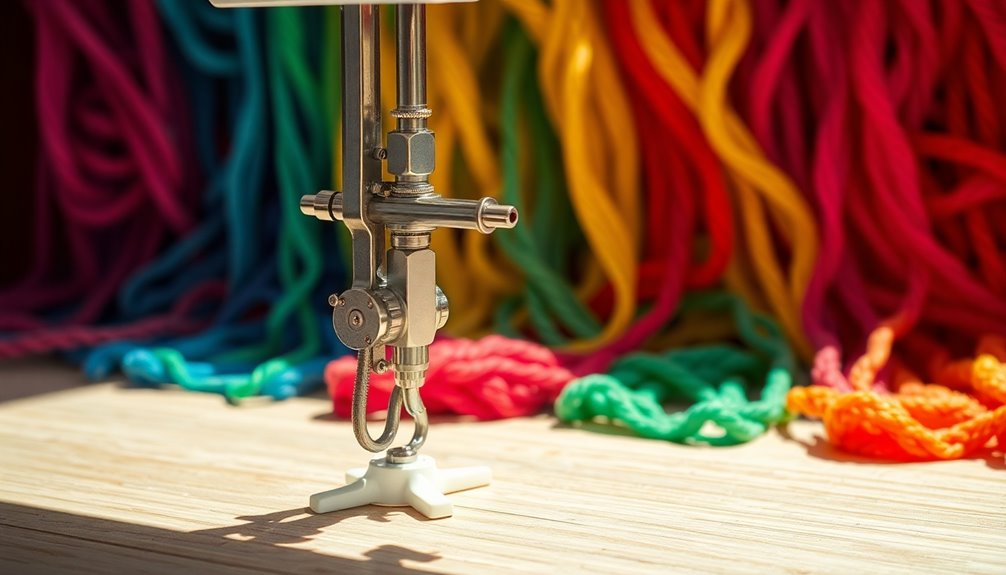
With the rise of machine-made crochet-like items, the landscape of crochet is changing rapidly. The impact of mass production raises several concerns for artisans and consumers alike:
- Lower-quality materials compromise durability and aesthetic.
- Handmade crochet reflects unique artistry and individual craftsmanship.
- Machine-made goods lack the personal touch that defines authentic crochet.
- Intricate techniques are lost in the efficiency of mass production.
- Ethical concerns arise over fair compensation for artisans versus cheaper alternatives.
As crochet enthusiasts, you might find it disheartening to see the authenticity of handmade crochet being overshadowed by uniformity. The rise of crochet kits for beginners serves as a reminder of the value of nurturing craftsmanship and creativity in a world increasingly dominated by mass production.
The debate on the value of craftsmanship continues, emphasizing the need to appreciate and support the artistry that makes crochet truly special.
Exploring the Potential of Crochet Machines
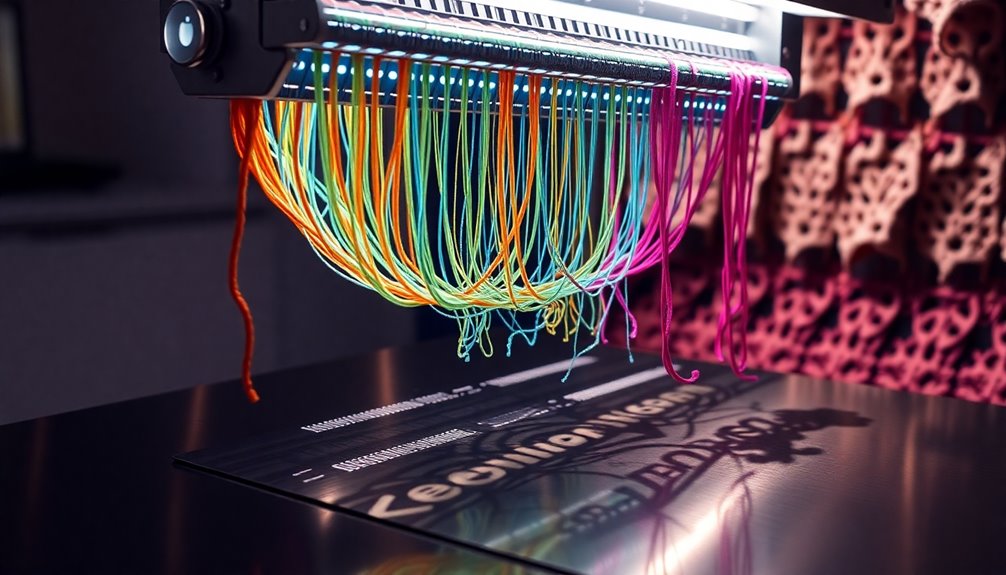
The potential of crochet machines sparks intrigue among enthusiasts and manufacturers alike. While automated machines can manage basic crochet stitches, they struggle with intricate patterns that require human dexterity.
Current technology falls short of replicating the artistry found in hand-crocheted items, particularly when it comes to complex patterns like lacework. Although some machines can produce a crochet-like appearance through warp knitting, they lack the unique stitches and textures that define traditional crochet.
The personal touch artisans bring is irreplaceable, contributing to the uniqueness of handcrafted pieces. As AI and robotics evolve, they might enhance machine capabilities, but achieving the full artistic aspects of crochet remains a significant challenge.
For now, nothing beats the skill and creativity of human hands.
Frequently Asked Questions
Can Crocheting Be Done by a Machine?
You might think that machines could handle crocheting, but it's not that simple.
Unlike knitting, which machines can automate, crocheting requires your hands to manipulate yarn loops in a unique way.
Sure, some machines create fabric that looks similar, but they can't replicate the intricate techniques or personal touch that comes from handwork.
The complexity of crochet stitches means it's truly an art form best left to skilled hands like yours.
Is It Possible for a Robot to Crochet?
While over 30 million people in the U.S. crochet, robots still can't replicate the art.
You might think machines could take over, but they struggle with the intricate loops and tension required for true crochet.
Some automated systems can mimic crochet-like appearances, yet they fall short in creating the unique textures and patterns you achieve with your hands.
For now, the creativity and craftsmanship of human crocheters remain unmatched by any robot.
Can You Put Crochet Through a Sewing Machine?
Yes, you can put crochet through a sewing machine, but you need to be careful.
Since crochet stitches are unique, you might encounter challenges with traditional techniques. Use a longer stitch length to prevent puckering, and consider a walking foot to manage the thickness.
Can Granny Squares Be Machine Made?
While you might wonder if granny squares can be machine-made, the truth is that machines struggle to replicate their intricate designs.
They can create basic square shapes but can't capture the unique texture and personal touch that comes with hand crochet.
Each stitch in a granny square reflects your individual style, something mass production simply can't achieve.
Conclusion
In the tapestry of crafting, crochet remains a vibrant thread woven by human hands. While machines may hum with potential, they can't replicate the warmth and creativity that flow from your fingertips. As you explore the future of crochet, remember that each stitch tells a story, a unique expression of artistry that machines struggle to mimic. Embrace the beauty of handmade creations, and let your passion for crochet shine brighter than any automated process ever could.

